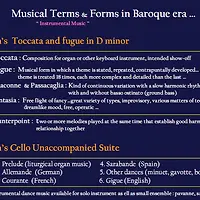클래식 음악을 배우기 전에 먼저 잠깐 짚고 넘어갈 것이 Gregorian Chant. 클래식음악의 어머니 뻘 된다고 봐야 할까?
아직은 하모니(화음)가 자리를 잡기 이전이라 주로 단일 멜로디로 구성이 되어 있으며, 급격한 멜로디의 변화가 없는 것을 특징으로 한다. 유대교나 천주교 의식에서 들려오는 음악(아~알 렐루야~~ 하는 식의)을 떠올리면 될 것 같다.
시대적인 관점에서 보면 이 당시 음악은 종교 의식의 일부분이었던 시절이다. 미술도 그렇고 음악도 그렇고, 사실 문학도 그렇고 기독교를 떠나서는 생각할 수 없던 시절이 있는 것 같다. 물론 서양역사에서 말이다.
재미 있는 것은 조지윈스턴의 파이노 연주로 익숙해진 파헬벨의 캐논도 이 Gregorian Chant의 한가지 형식이라는 점이다.(아래 그림 참조) Cannon은 돌림노래와 같이 연주되는 형식을 의미한다고 한다.
Listening List
1.Introit (입당송)
2.Kyrie (기리에)
3.Gloria (대영광송)
4.Gradula (층계송)
5.Alleluia (알렐루야)
*** Gregorian Chant
The early music of the Christian church was shaped in part by Greek, Hebrew, and Syrian influences. In time it became necessary to assemble the ever growing body of music into an organized liturgy. The task extended over several generations tradition credits Pope Gregory the Great (resigned 590-604).
Like the music of the Greeks and Hebrews, Gregorian chant(also known as plainchant or plainsong)consists of a single-line melody; in other words, it is monophonic in texture, lacking harmony.
The Gregorian melodies, numbering more than three thousand, form an immense body of music, nearly all of it anonymous. Gregorian chant avoids wide leaps and dynamic contrasts, allowing its gentle contours to create a kind of musical speech.
At first the chants were handed down orally from one generation to the next. As the number of chants incresed, singers needed help in remembering the general outlines of the different melodies. Thus neumes, little ascending and descending signs, were written above the words to suggest the contours of the melody. Neumes eventually developed into a musical notation consisting of square notes on a four line.
The Melody fall into three classes ;
1. Syllabic - one note sung to each syllable
2. Neumatic - two to four note sung to a syllable
3. Melismatic - long groups of notes set to a single syllable
*** Movements and Order of the Mass
The Mass, a reenactment of the sacrifice of Christ, is the most solemn ritual of the Roman Catholic Church. The collection of prayers that make up the Mass fall into two categories :
1. Proper - texts that vary from day to day throughout the church year, depending on the feast being celebrated
2. Ordinary - texts that remain the same every Mass

![]()
Composers concentrated their musical settings on the Ordinary, the fixed portion of the Mass that sung daily. This practice brought into five main sections of the Mass.
1. Kyrie : prayer for mercy
2. Gloria : Glory be to God on high (joyful hymn)
3. Credo : confession of faith (logest of the Mass texts)
4. Sanctus : Holy, holy, holy (Hosanna in the highest)
5. Agnus Dei : Lamb of God, Who takes away the sins of the world
"miserere nobis" & "dona novis pacem"
(sung 3times, twice "Have mercy on us", third time prayer grant us peace )
'음악 이야기 > Talk' 카테고리의 다른 글
| KAIST 김정진 교수님의 서양음악사 - [번외] 조바꿈(Modulation) (0) | 2009.03.05 |
|---|---|
| KAIST 김정진 교수님의 실내악특강 - 7. 연탄곡, 밴드(Zeil Zaza - I'm alright) (0) | 2009.03.05 |
| KAIST 김정진 교수님의 서양음악사 - 3. 바로크 시대(Baroque Era) (1) | 2009.03.04 |
| KAIST 김정진 교수님의 서양음악사 - 1. What is Classical Music? (0) | 2009.03.03 |
| [펌] 바로크 음악을 대표하는 두 작곡가, 바흐와 헨델 (0) | 2009.02.12 |

